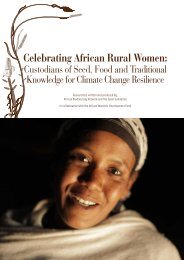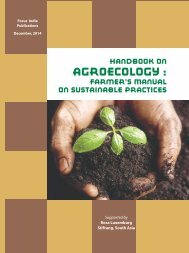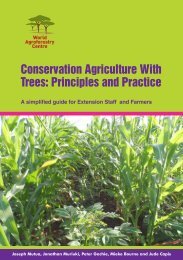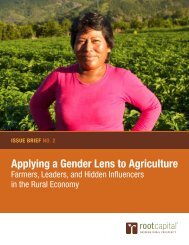1t0SC7l
1t0SC7l
1t0SC7l
Create successful ePaper yourself
Turn your PDF publications into a flip-book with our unique Google optimized e-Paper software.
4) To propose solutions for farmers’ problems and constraints related to forest conservation<br />
and agricultural production, in order to reduce the destruction of the forest by the farmers,<br />
thereby achieving sustainable management of the forest zone of southern Cameroon.<br />
1.3 THE RESEARCH AREA<br />
The TCP research site corresponds to the 180 000 ha of the concessions of Wijma Douala<br />
SARL (GWZ). It is located 70 km east of Kribi (Figure 1.1), between 2° 47’ and 3° 14’ North,<br />
10° 24’ and 10° 51’ East, and between the low altitude evergreen forest and the mid-altitude<br />
evergreen Atlantic forest (Franqueville, 1973), characterised by the presence of Lophira alata<br />
(Azobé). It is part of the South Province of Cameroon, and includes parts of the Akom II,<br />
Bipindi and Lolodorf subdivisions (Océan Division), and the Ebolowa subdivision (Mvila<br />
Division).<br />
1.3.1 Characteristics of the physical environment<br />
Climate<br />
The climate of the research area is equatorial, classified as humid tropical (Köppen, 1936),<br />
characterised by two rainy seasons and a short and a long dry season (Figure 1.2). The average<br />
rainfall per year is about 2000 mm. The monthly mean rainfall are 200 and 400 mm for April /<br />
May and September / October, respectively. October is the wettest month of the year. The two<br />
driest periods of the year are December / February and July / August, respectively, with less<br />
than 80 mm of rainfall per year. The bimodal rainfall pattern determines two growing seasons.<br />
The first starts in March and ends in June; the second starts in August and ends in November.<br />
Between the two seasons, from December to March, arable swamps and valley bottoms are<br />
cultivated that allow to produce off-season food crop. Such a climate has a mean temperature<br />
above 18°C during the coolest month, an annual temperature around 25°C with very little<br />
variation during the year, and finally a well delineated dry season.<br />
A summary of climatic data from selected meteorological stations surrounding the research area<br />
is given in Table 1.1.<br />
Table 1.1: Summary of climatic data from selected meteorological stations<br />
Meteorological station Kribi Lolodorf Ebolowa<br />
Altitude (m asl) 13 440 609<br />
Mean annual temperature (°C) 26.4 24.6 24.0<br />
Relative humidity (%) 84 n.a. 83<br />
Mean annual vapour pressure (mbar) 29.3 n.a 24.6<br />
Mean annual rainfall (mm) 2836 2096 1719<br />
Wind speed below 4 m. / s (% time) 98 n.a. n.a.<br />
Mean wind direction SW n.a W<br />
Kribi, n = 45 years; Lolodorf, n = 25 years; Ebolowa, n = 48 years; n.a. = not available<br />
Source: Olivry (1986).<br />
Vegetation<br />
Van Gemerden and Hazeu (1999) described the vegetation of the study area in detail. It belongs<br />
to the Biafran Atlantic forest district of low and medium altitude (Letouzey, 1985).<br />
Characteristics of the sub-mountain part of the Guineo-Congolian domain are found on some<br />
isolated hills. Along the main roads, and around villages and in agricultural zones, the<br />
vegetation is strongly influenced by the human activities, and characterised by the presence of<br />
various pioneer species. The spatial distribution of the various vegetation types distinguished by<br />
van Gemerden and Hazeu (1999) is shown in Annex 1.<br />
3








